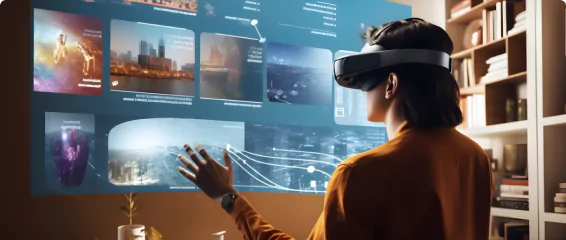Machine Learning and AI for revolution of Tech Companies are changing and streamlining businesses.
Nowadays, businesses are recognizing the power of digital transformation in customer experience (CX), which can enhance the overall customer journey. With time, customer expectations are rising, and organizations must embrace digital transformation to offer personalized, engaging, and overall better digital experiences across various touchpoints.
This not only enriches the customer experience but also enhances the brand image. With modern technologies, we will see even more options that transform the customer experience. ViitorCloud helps businesses offer engaging and innovative customer experiences. Check out our latest digital experience solution on LinkedIn.
Now, let’s discuss how digital technologies can make the digital customer experience better.
Check: Importance of Digital Experience Monitoring Solutions
The Significance of Transforming Customer Experience
So, it goes without saying that customer experience has made a lot of difference in today’s market, where it is hard to attract and retain customers. Forrester’s 2024 US Customer Experience Index states that companies with better customer experience quality see 41% faster revenue growth.
And digital transformation has completely changed how businesses approach customer experience. With proper utilization of advanced technologies and data analytics, they can make customer interaction better, which leads to loyalty, better business performance, and customer satisfaction.
A McKinsey study states that a customer experience digital transformation can generate a 20-30% increase in customer satisfaction, a 10-20% improvement in employee satisfaction, and 20-50% economic gains of the cost base addressed in various journeys. Other important statistics show:
- 35% of business executives confirm digital transformation helps meet customer expectations better
- Digitally mature companies are 23% more profitable than their less mature counterparts
- By 2025, AI is predicted to drive 95% of customer experiences
These statistics clearly show the importance of prioritizing customer experience transformation. With the right digital transformation strategies, businesses can understand what customers need, their preferences, and their behaviors. Such data insights allow businesses to create customer experiences that attract new customers, retain existing ones, drive repeat purchases, and eventually increase revenue.
Transform your customer experience with our innovative digital solutions. Enhance engagement and drive growth today.
Impact of Digital Transformation on Customer Experience
As stated in the previous section, businesses need to go through digital transformation and embrace various advanced technologies to offer better CX. Here’s how the impact of digital transformation in customer experiences can transform the way companies interact with their customers and shape the future of customer experience:
1. Personalization and Hyper-Personalization
Personalization is now considered for customer experiences. With available customer data and insights, businesses can design their offerings, content, and interactions to individual preferences and needs. Redpoint and Harris found that 54% of consumers are willing to share personal data for a superior experience.
Taking personalization to the next level, hyper-personalization uses advanced data analytics, AI, and real-time data to offer highly contextualized and individualized experiences. This level of personalization not only enriches customer satisfaction but also increases loyalty and repeat business.
2. Instant Service and Self-Help with AI and ML
Artificial Intelligence (AI) and Machine Learning (ML) are obviously transforming the way businesses interact with customers. Organizations can automate processes, integrate new systems, and use predictive analytics to forecast customer demand and deliver proactive support with the proper use of AI and ML.
Chatbots, powered by AI, are a great example here as they provide 24/7 customer support, engage in conversational interactions, and resolve queries without human intervention. According to ChatBotsMagazine, chatbots can trim customer support service by 30%.
3. Customer Journey Mapping
Digital transformation in customer experience helps map the customer journey. Customer journey mapping is a powerful tool for visualizing and understanding the multiple touchpoints a customer interacts with on their path to purchase. With this, businesses can identify pain points, optimize experiences at each stage, and create strategies to satisfy customer expectations.
Customer journey maps allow businesses to analyze actual customer needs, compare the actual experience with benchmarked standards, and analyze the buying funnel as customers move through various stages. Such insight allows businesses to personalize services and create meaningful connections with customers.
4. Omnichannel Customer Engagement
Customers expect smooth experiences across multiple channels and devices. Omnichannel customer engagement involves integrating various touchpoints, such as websites, mobile apps, social media, and physical stores, to provide a unified brand experience.
Salesforce reports that 60% of customer touchpoints now take place online, which shows the importance of digital channels in the customer journey. With an omnichannel approach, businesses can ensure that customers can easily switch between channels while maintaining their preferences, shopping carts, and browsing history.
5. Voice and Conversational Interfaces
Voice-activated devices and conversational interfaces are transforming how customers interact with businesses. The convenience and accuracy of voice recognition technology are driving its adoption in customer service and beyond.
Voice assistants like Amazon’s Alexa, Google Assistant, and Apple’s Siri are being integrated into customer service strategies. This allows customers/users to perform tasks, make inquiries, and receive support through voice commands. Advanced chatbots and voice bots, powered by artificial intelligence capabilities, can understand and respond to complex queries and provide human-like interactions to handle various queries.
Revolutionize your customer interactions with advanced digital solutions that enhance satisfaction and loyalty.
Customer Experience Technology Examples
To highlight the practical applications of digital technology in transforming customer experience, here are some examples:
1. Generative AI and Machine Learning
In the last few years, AI has become very important to Gen Z and millennial customers for better experience. A Gartner report predicts that by 2025, 80% of customer service and support organizations will be using generative AI in some way or another. Here’s how AI is transforming customer experience:
Chatbots and Virtual Assistants
- 24/7 customer support availability
- Instant response to common queries
- Reduction in support costs by up to 70%
Predictive Analytics
- Anticipating customer needs
- Personalizing recommendations
- Preventing customer churn
2. Omnichannel Experience Technology
Modern customers expect seamless interactions across all touchpoints. Research shows that 73% of customers prefer businesses that use multiple channels to reach them and offer personalized experiences. Main components include:
- Consistent but not irritating messaging across channels
- Seamless transition between devices
- Integrated customer history
3. Conversational User Interfaces (CUIs)
Conversational User Interfaces can completely change how customers interact with businesses. This technology is already showing impressive results, with businesses reporting up to 35% improvement in customer satisfaction scores when using advanced CUIs.
Benefits for Businesses:
- Reduced customer service response times
- Improved self-service adoption rates
- Customer engagement through natural conversations
- Integration with existing customer service platforms
4. Mobile-First Technologies
With 54% of global internet traffic coming from mobile devices, according to Statista, mobile optimization is important to make the customer experience better and even to reach them.
Mobile Experience Enhancement
- Responsive design
- Fast loading times
- Simplified navigation
5. Augmented and Virtual Reality
AR and VR are revolutionizing how customers interact with products and services. One of the biggest and most popular examples is the IKEA app. Augmented reality within the IKEA app allows users to see how furniture would look in their house. This impacts customers’ buying decisions and makes their experience even better.
Virtual Try-Ons
- Digital product visualization
- Interactive product demonstrations
- Immersive shopping experiences
Drive business growth by transforming customer experiences through innovative digital technologies and insights.
The Future of Customer Experience in the Digital World
As we are crossing the first half of this decade, the future of customer experience seems even more transformative. New techs like 5G, extended reality (XR), and edge computing will make the impossible possible in terms of customer experiences.
5G
5G networks across the world will provide even faster internet connectivity on the go and this will open doors for virtual try-ons and immersive product demos anytime, anywhere.
XR
Extended reality, combining virtual reality (VR), augmented reality (AR), and mixed reality (MR), will blur the lines between the physical and digital worlds. Customers will be able to interact with products and services in entirely new ways, and we offer AR, VR, and MR Development Services.
Edge Computing
This will put data processing even closer to the source and reduce latency. Eventually, it will empower businesses to provide more personalized experiences based on customers’ location, behavior, and preferences.
Also Read: 10 Ways AI Will Improve Customer Experience in 2024?
Elevate your customer journey with cutting-edge digital transformation strategies for unparalleled engagement.
Final Words
Hence, we can say that new digital technologies have the power to transform customer experience in many innovative ways. With the right use of digital transformation in customer experience, businesses can build long-term relationships with customers and enhance their experience.
ViitorCloud can be your trusted partner in this journey. With our expertise in AI, AR/VR, IoT, and other emerging technologies, we can help you offer a better customer experience to improve your brand image and engage customers for more. Contact us and learn how we can help you transform your customer experience and drive business growth.
Frequently Asked Questions
Digital transformation improves customer experience by using techs like AI and machine learning to offer personalized, seamless interactions across multiple touchpoints. This transformation allows businesses to meet rising customer expectations effectively- meaning increased satisfaction and loyalty.
For customers, digital transformation means more personalized and convenient experiences. It involves businesses using technology to customize interactions and services to individual preferences for a more engaging and efficient customer journey.
Customer experience transformation involves a strategic overhaul of how businesses engage with customers across all touchpoints. It requires reimagining processes, integrating customer feedback, and adopting new technologies according to customer behaviors and expectations.









